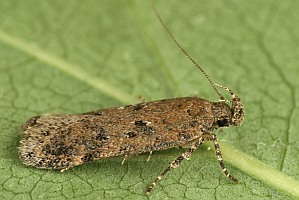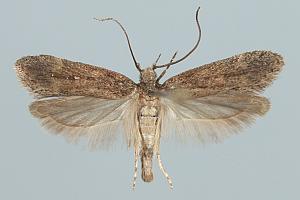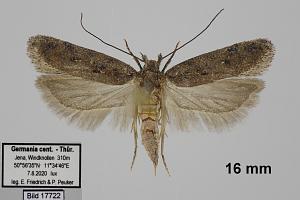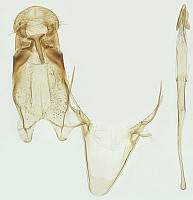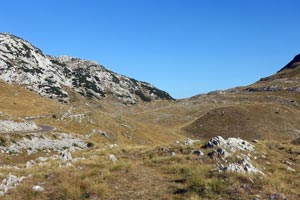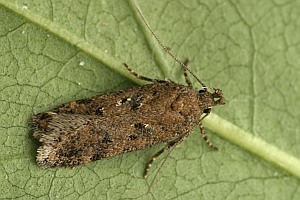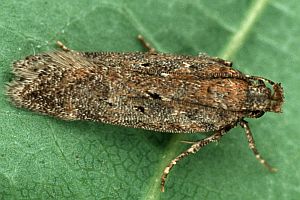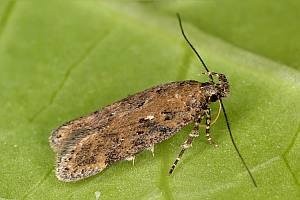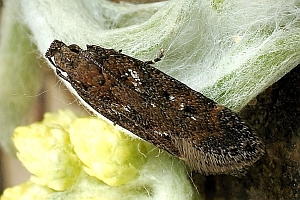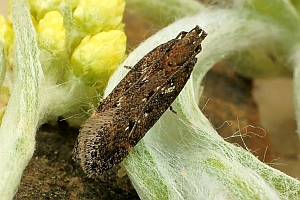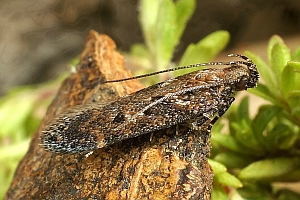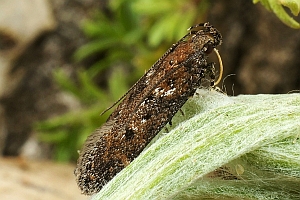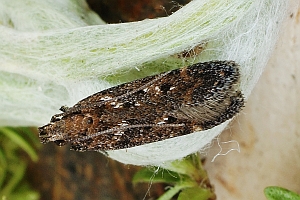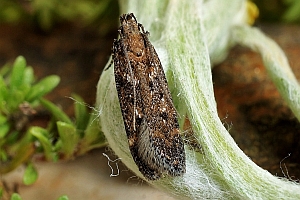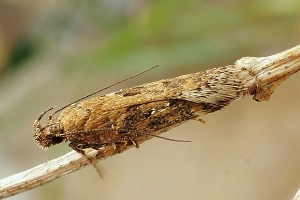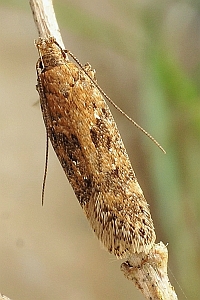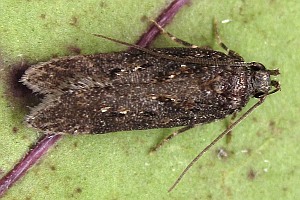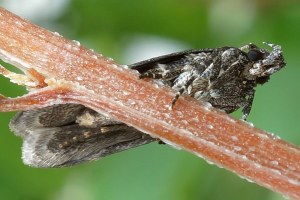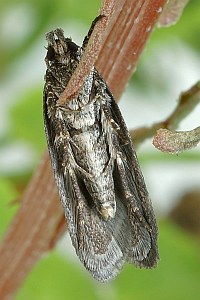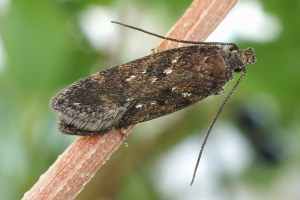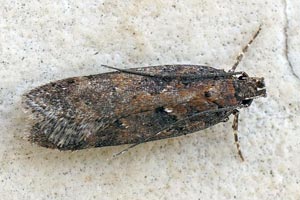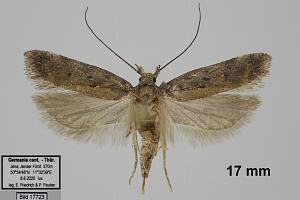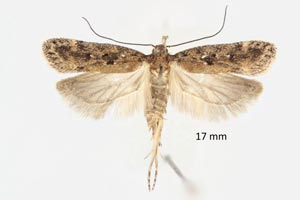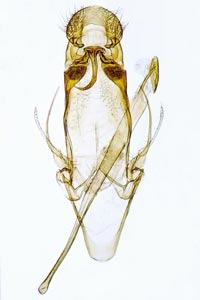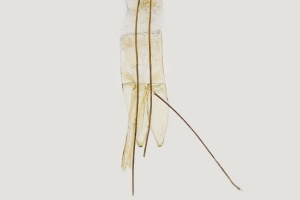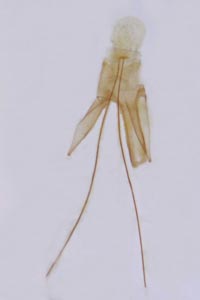

 +38Kontinente:EUAS
+38Kontinente:EUAS1. Lebendfotos
1.1. Falter
2. Diagnose
2.1. Männchen
2.2. Weibchen
2.3. Genitalien
2.3.1. Männchen
2.3.2. Weibchen
2.4. Erstbeschreibung
3. Biologie
3.1. Habitat
4. Weitere Informationen
4.1. Etymologie (Namenserklärung)
Synonym Ancylis cerdanica: Nel, Varenne & Peslier (2020: 69) erläutern: „« cerdanica » pour rappeler la patrie d'origine de l'espèce, vraisemblablement une endémique pyrénéenne.“
4.2. Andere Kombinationen
- Gelechia distinctella Zeller, 1839 [Originalkombination]
4.3. Synonyme
- Chionodes praeclarella Herrich-Schäffer, 1854
- Gelechia striolatella Heinemann, 1870
- Gelechia tristella Teich, 1889
- Gelechia indistinctella Rebel, 1901
- Gelechia latiorella Amsel, 1939
- Chionodes deserticola Piskunov, 1979
- Chionodes cerdanica Peslier, Nel & Varenne, 2020 [synonymisiert durch Huemer & van Nieukerken (2021)]
4.4. Unterarten
- Gelechia distinctella unicolor Toll, 1947
4.5. Taxonomie
Nel, Varenne & Peslier (2020: 68) beschrieben ihre "Ancylis cerdanica" nach einem einzigen ♀, ohne eine DNA-Untersuchung durchzuführen. Hätte man mit der Veröffentlichung der Beschreibung noch gewartet, bis ein Barcoding-Ergebnis vorlag, wäre uns ein Synonym erspart geblieben. Jedenfalls fällt das Taxon genetisch voll und ganz in die Variationsbreite von C. distinctella und größere Abweichungen in Teilen des Genitals deuten hier eher auf einen (genetisch bedingten?) Genitaldefekt hin als auf eine eigenständige Art. Doch innerhalb C. distinctella scheint es tatsächlich 2 Cluster zu geben, die es Wert wären, genauer studiert zu werden. Huemer & van Nieukerken (2021: 323) erläutern zu C. cerdanica: "The holotype shows some unique features in genitalia, particularly the short and triangular antrum and the digitate distal part of the apophyses anteriores. However, the fully recovered DNA barcode despite not being barcode compliant, clearly indicates possible conspecifity with C. distinctella (Zeller, 1839). This species shows some genetic variation represented by a barcode cluster occurring in Finland and a widespread cluster in Europe with considerable genetic variation of 2.15% within this BIN (Huemer et al. 2020). The holotype of C. cerdanica nests in a geographically widespread cluster with only ca. 0.6% divergence from the nearest neighbour. Furthermore the female genitalia of both taxa are at least partially similar in the broad apophyses anteriores. Curiously, Nel et al. (2020) described the ductus and corpus bursae of C. cerdanica as transparent whereas they also stated that these structures were not found during preparation. Whereas the entrance of the ductus bursae is always visible at the anterior end of the antrum in Chionodes, it seems to be completely reduced in this specimen. Therefore we believe that the specimen is likely the result of a rare mutation or of a developmental anomaly that led to genitalia malformation." Sie sehen darin eine Parallele zum Fall "Mesapamea remmi".
(Autor: Erwin Rennwald)
4.6. Typenmaterial
Synonym Ancylis cerdanica: Nel et al. (2020: 68) erläutern: « HOLOTYPE femelle : France, Pyrénées-Orientales, Dorres (Ventajols), 1 600 m, 9 août 2019, S. Peslier leg., prép. gen. JN n° 33968, Coll. S. Peslier à Perpignan. »
4.7. Literatur
- Huemer, P. & E. van Nieukerken (2021): Identity of some recently described Lepidoptera from France — re-assessed with DNA barcodes and morphology. — Zootaxa 4941 (3): 301–337. [zum open-access-Artikel und PDF-download auf mapress.com]
- Beschreibung als Chionodes cerdanica: Nel, J., Varenne, T. & S. Peslier (2020): Descriptions de cinq nouveaux microlépidoptères : Isophrictis lineatella littorella ssp. n., Chionodes cerdanica sp. n., Ancylis paraobtusana sp. n., Epiblema bonifaciensis sp. n. et Dichrorampha mazeli sp. n. (Lepidoptera, Gelechiidae, Tortricidae). — Revue de l'Association Roussillonnaise d'Entomologie 29 (1): 66-74.
- SCHÜTZE (1931): 14
- Erstbeschreibung: Zeller, P. C. (1839): Versuch einer naturgemäßen Eintheilung der Schaben. — Isis von Oken 1839 (3): 167–220. Leipzig (Brockhaus).






































